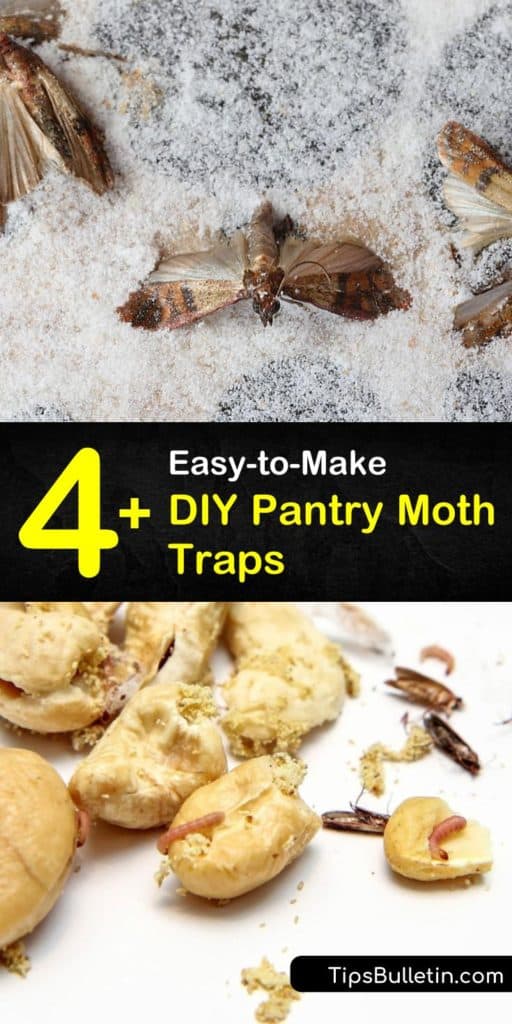A pantry is one of the best areas of the house, often full of good smells and bursting with delicious potential. Each person’s pantry tells a bit of a story about them, but the story we don’t want is one involving moths eating everything. Instances of moth invasions are the perfect opportunity to use homemade pantry moth traps.
DIY moth traps serve to eliminate any problems with the creatures as well as help detect a new invasion. Keeping one or two traps set out helps to catch any critters that sneak in before they can wreak havoc. Pantry moths, typically Indian meal moths, require something different than typical outdoor moth traps. Part of this is due to location.
In a pantry, you don’t want nasty smelling substances lying out or insect tape you can walk into. To get rid of pantry moths, lure them to the traps and get them stuck inside, effectively controlling the pantry moth infestation.

DIY Moth Traps
Before you set out moth traps, get rid of any hint of the moths at any point in their life cycle for effective pest control. How long do moths live? It depends on the species, but most moths live as an adult for one to two months.
The female moths lay eggs once they have eaten their way through their food source. These hatch into moth larvae, feed on various dry food items and then turn into pupae in cocoons.
Clean Out the Pantry
If you find small moths in kitchen areas or are looking for natural ways to keep weevils away, it’s time to take action. Start by thoroughly cleaning out the entire pantry as the best way of getting rid of pantry mites, moths, and other bugs. Focus primarily on food containers that have things like cornmeal, pet food, bird seed, dried fruit, or other common dry foods.
Clean everything off the pantry shelves. Moth larvae and weevils are also attracted to dust left by pasta and rice. Wiping the shelves is also an excellent way of getting rid of flour mites or other bugs like a rice weevil infestation that may have found their way into your food storage area.

For more of a moth problem than you thought, use hot water and a rag to clean up any pantry moth eggs remaining. If you find any moths or larvae in plastic containers, dump them into airtight plastic bags, seal them, throw them in trash bags and remove them from home.
Look for evidence of webbing to catch all moth stages. After the pantry is free of them, look for crevices that they could have entered.
The point is to stop insects coming in, preventing silverfish, species of moths, and other irritating insects. Seal potential entryways off to stop future infestations.
Make Your Own Pheromone Traps
Start the DIY clothes moth traps process by making pheromone traps. These pantry pest traps naturally attract moths inside, lured by the pheromones, and then act as an exterminator.
The only thing you should need to purchase for these homemade pantry moth traps is the pheromones. Find them online or in most home improvement and hardware stores.
For getting rid of moths naturally, take the empty, plastic juice bottle and poke holes in the top part of the bottle with the scissors. Enlarge these holes by cutting sections about 1 ½ inches long and ⅜ inches wide. These holes should be where the moths enter the bottle.
Place the pointed end of the screwdriver, should be a Phillips to be effective, in the center of the bottle cap. Hammer down hard to punch a hole through this cap.
Take the cap off the bottle and string the twine through the hole. Know the end that sticks out of the bottom of the cap.
Fill the bottle with approximately two inches of water and a small amount of dish soap, mixing it to create soapy water. Put on a pair of gloves to keep the pheromones off of your hands.
Use tape to attach a strip of moth pheromone onto the bottom of the cap or inside the bottle. Tie the bottle in an easily accessible area in the pantry for the moths.
The Light and Water Trap
It is common knowledge that nighttime insects, particularly moths, are attracted to bright lights. Typically, they are outdoors, and you can see them swarm around the light. Use this affinity for light to get rid of moths on your porch or back deck with this clever moth trap.
Fill whatever dish or container you choose to use partway up with a water and dish soap mixture. You only need a couple of squirts of dish soap to kill any moths that land in the container.
Place the dish right under very bright light, preferably the only one that will always stay on during the night. When they attempt to fly around the light, they inevitably dive into the soapy water.
You may also find that this solution works well as fly and gnat traps. Replace the trap when it gets full.
Homemade Pantry Moth Traps: Herb Sachets
Another one of the home remedies for how to get rid of moths is to make herb sachets. These make effective repellents to deter moths from entering or encourage them to leave, functioning similarly to mothballs.
Herbs are also natural pesticides. Fill sachets with a mix of bay leaves, lemon peel, cinnamon, peppermint, black pepper, or coriander. Hang these up in areas you want to keep moths away from, particularly their favorite foods.
DIY Clothes Moth Traps
Herbs not only repel pantry moths but other types of moths, as well. Use this spray in your pantry or closet to get rid of clothes moths.
Herbal Spray
Making an herbal spray is another effective way to stop moths from entering the home or trap them in the mist when caught. For these homemade pantry moth traps, there are two options when formulating your spray.
You can boil herbs, such as lemongrass, lavender, and some lemon slices. Simmer the herbs in water on the stove for a while, allowing them to steep. When the water cools, strain the liquid into a spray bottle, leaving out the herbs.
The other method to make an herbal spray even more reliable is by adding essential oils into the spray bottle water. Peppermint oil works well in this case, but you can also mix in some lavender or rosemary.
To use the concoction, spray around any areas you recently sealed, any dry foods preferred by moths, and the corners of the shelves.
Armed with repellents and homemade traps, no moths stand a chance if they try to come into your pantry. Some people are surprised that to effectively get rid of moths, there are no chemicals required, but herbs can do quite an efficient job.

With the methods listed here and remedies from fresh-smelling essential oils, we hope that you never struggle against an invasion of moths again. If you learned something new about making homemade pantry moth traps, please share our DIY moth trap tips on Facebook or Pinterest.